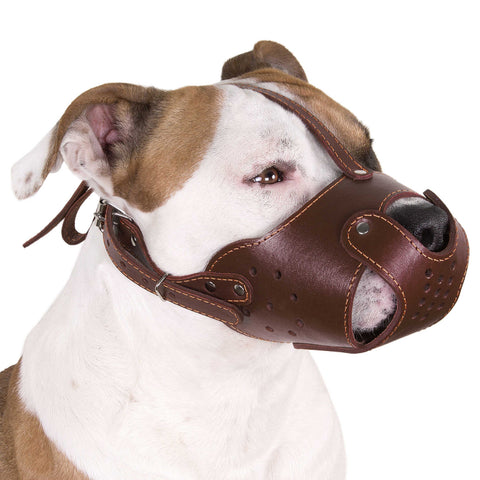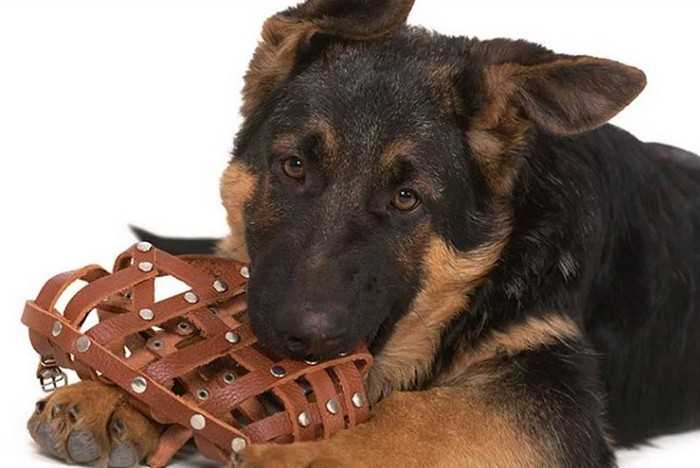A dog muzzle is a device designed to prevent dogs from biting people or other animals. Muzzles come in various shapes and sizes, and can be made from materials such as leather, cloth, plastic, or wire. While muzzles are not meant to be used as a permanent solution for aggressive dogs, they can be an effective tool for managing their behavior in certain situations.
One of the main reasons that dogs may bite is due to fear or anxiety. Dogs who are scared may bite in self-defense, even if they are usually friendly and well-behaved. Muzzles can help prevent bites in these situations by reducing the dog's ability to open its mouth and bite. Additionally, muzzles can help prevent bites from dogs who are experiencing pain, such as dogs with dental problems or dogs who have recently undergone surgery.
Another common reason that dogs may bite is due to territorial or possessive aggression. Dogs may become aggressive towards people or other animals who they perceive as a threat to their possessions, such as their toys, food, or bed. Muzzles can be used in these situations to help reduce the dog's ability to bite while it is being managed or trained.

It is important to choose the right size and type of muzzle for your dog, as an ill-fitting muzzle can be uncomfortable and cause further anxiety for the dog. Soft, cloth muzzles are generally more comfortable for short-term use, while wire or basket muzzles allow for more panting and drinking and are suitable for longer-term use. Some muzzles also have a metal bar in front that prevents the dog from biting, but allows them to open their mouth to pant and drink.
It is also important to remember that while a muzzle can prevent bites, it does not address the underlying behavior that is causing the dog to bite in the first place. Aggressive behavior should be addressed through positive reinforcement training, which involves teaching the dog alternative behaviors and rewarding it for good behavior. A professional dog trainer or behaviorist can help you develop a training plan for your dog.

What to do to choose the right dog muzzle to prevent biting
What is the best dog muzzle for biting? Choosing the right dog muzzle to prevent biting can be a bit challenging, but by following these steps you can find one that will fit your dog comfortably and serve its purpose effectively:
- Determine the purpose of the muzzle: Consider why you need a muzzle for your dog. Is it to prevent biting in specific situations, or to manage their behavior in general? Different muzzles have different levels of restriction, so it's important to determine the purpose before making a purchase.
- Measure your dog's snout: Measure the circumference of your dog's snout just below the eyes and the length from the tip of their nose to just below their eyes. This information is crucial in choosing the right size muzzle for your dog.

- Consider your dog's breed: Some dog breeds have specific snout shapes and sizes, so it's important to consider their breed when choosing a muzzle. If your dog is a mixed breed, look for a muzzle that is suitable for dogs with similar snout shapes and sizes.
- Choose the right material: Muzzles are made from different materials such as leather, cloth, plastic, or wire. Consider the environment in which your dog will be wearing the muzzle. Wire or basket muzzles provide more ventilation and are suitable for extended use, while soft cloth muzzles are more comfortable for short-term use.
- Try the muzzle on: Before making a purchase, try the muzzle on your dog to make sure it fits properly. The muzzle should fit snugly, but not too tight, and should not interfere with breathing or panting.

- Consider the design: Different designs of muzzles provide different levels of restriction. Basket muzzles offer the most freedom, allowing your dog to pant and drink, while cloth muzzles restrict the mouth more. Choose a design that will meet your needs and provide the level of restriction you require.
- Check for quality: Make sure the muzzle is well-made and durable, with no sharp edges or loose parts that could cause injury to your dog.
By following these steps, you should be able to choose the right dog muzzle to prevent biting. It's important to remember that muzzles are not meant to be used as a permanent solution for aggressive dogs, and that aggressive behavior should be addressed through positive reinforcement training and behavior modification.

Expert opinions that the right dog muzzle can prevent biting
- "A well-fitted muzzle can prevent biting in certain situations and can provide a level of safety for both the dog and those around them. However, it's crucial to understand that a muzzle should not be used as a long-term solution for aggressive behavior, but rather as a tool to be used in conjunction with positive reinforcement training and behavior modification." - Dr. Jessica Hekman, DVM, veterinary behaviorist.
- "The right dog muzzle can be a valuable tool in preventing biting and promoting safe behavior in dogs. It's essential to choose a muzzle that fits properly and allows for adequate breathing and panting, and to only use the muzzle in appropriate situations. The ultimate goal should be to address the root cause of aggressive behavior through positive reinforcement training and behavior modification." - Dr. Karen Louis, DVM, certified animal behaviorist.
- "Using the correct dog muzzle can prevent biting in certain situations and provide peace of mind for pet owners. However, it's crucial to understand that the muzzle should not be used as a crutch for improper training. The use of a muzzle should be combined with positive reinforcement training and behavior modification to address the underlying cause of aggressive behavior." - Dr. Ashley Gallagher, DVM, certified veterinary behaviorist.

How to train a dog to anti-biting dog muzzle to prevent biting
Training a dog to accept wearing a muzzle can take some time, but with patience and positive reinforcement, it can be done. Here are the steps to follow:
- Introduce the muzzle: Before you start training your dog to wear a muzzle, get them used to the idea of having it near them. Let them sniff it and get comfortable with it, and offer treats when they do so. Repeat this step several times, gradually increasing the amount of time they are exposed to the muzzle each time.
- Associate the muzzle with positive things: Start by putting a treat inside the muzzle and allowing your dog to take it out. Repeat this step several times, increasing the amount of time that your dog spends with their nose in the muzzle each time. You can also feed your dog their meals through the muzzle to associate it with positive things like food.

- Start putting on the muzzle: Once your dog is comfortable with the muzzle, start putting it on their face for short periods of time. Start by putting it on for just a few seconds, gradually increasing the amount of time that it is on each time. Be sure to praise and reward your dog for their calm behavior during this process.
- Condition to movement: Once your dog is comfortable wearing the muzzle for short periods of time, start incorporating movement into the training. For example, take a few steps with the muzzle on, then remove it and reward your dog. Gradually increase the amount of movement, until your dog is able to walk and play while wearing the muzzle.

- Practice in different environments: Once your dog is comfortable wearing the muzzle in familiar environments, gradually introduce it in new and different environments. This will help your dog become more confident and comfortable wearing the muzzle in all situations.
- Gradually increase the duration: As your dog becomes more comfortable wearing the muzzle, gradually increase the amount of time that they wear it. Start with short periods and gradually increase to longer periods until your dog is comfortable wearing the muzzle for extended periods of time.

It is important to note that training a dog to accept a muzzle should be done gradually, and positive reinforcement is key. Reward your dog for calm behavior and avoid using force or punishment, as this can make the process more difficult and lead to further behavior problems. If you are having difficulty training your dog to accept a muzzle, consider working with a professional dog trainer or behaviorist for assistance.
Muzzles can be an effective tool for preventing bites from dogs who are experiencing fear, anxiety, or aggression. However, it is important to choose the right size and type of muzzle for your dog, and to address the underlying behavior through training. A well-behaved, trained dog is a happier and safer pet for everyone involved.


